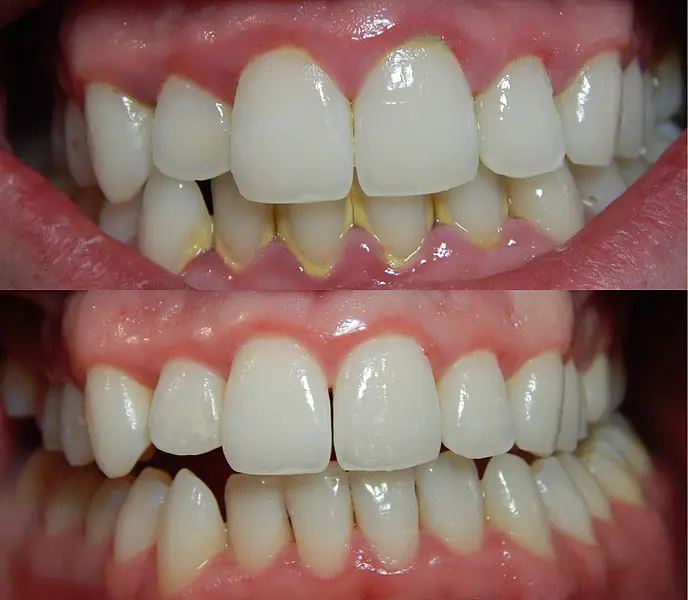Last Updated on 3 weeks by DR. ALBIN SIPES
After a deep cleaning, it takes approximately one to three weeks for gums to reattach.
We’ll explore how long it takes for gums to reattach after a deep cleaning and provide tips for promoting gum health.
Understanding The Process Of Gum Reattachment
Deep cleaning plays a crucial role in the reattachment process of gums affected by periodontal disease. During this condition, the gums become inflamed due to bacteria and plaque buildup, resulting in gum recession and detachment from the teeth. Deep cleaning, also known as scaling and root planing, involves removing bacteria, tartar, and plaque from tooth and root surfaces.
This process helps to create a clean and smooth environment for the gums to heal and reattach to the teeth. The duration for gums to fully reattach after deep cleaning can vary from person to person. It depends on factors such as the severity of the periodontal disease and individual healing capabilities.
However, with proper oral hygiene practices and regular dental check-ups, the gums can typically reattach within a few weeks to a few months. Following the dentist’s instructions and maintaining good oral hygiene is important to support the healing process and ensure long-lasting gum reattachment.
Timeline For Gum Reattachment Process
The healing process for gum reattachment after deep cleaning varies depending on several factors. The initial healing period typically takes a few days to several weeks. The length of time can be influenced by factors such as oral hygiene habits, the severity of gum disease, and the individual’s overall health.
Healthy oral habits, including proper brushing and flossing techniques, can contribute to faster healing. If gum disease is more advanced, it may take longer for the gums to reattach. Individuals with compromised immune systems or medical conditions like diabetes may experience a slower healing process.
Regular dental check-ups and cleanings can help monitor the progress of gum reattachment and ensure proper oral health.
Influential Factors For Gum Reattachment Speed
Gum reattachment speed after deep cleaning varies depending on the severity of periodontal disease, individual healing abilities, and oral hygiene maintenance. Factors such as the extent of gum inflammation, the depth of gum pockets, and underlying bone loss influence the time it takes for gums to reattach.
Additionally, each person’s natural healing abilities play a role in reattachment. Regular and proper oral hygiene practices, including brushing, flossing, and professional cleanings, can help promote faster gum reattachment. It is important to note that the healing process is unique to each individual and may take several weeks or even months.
By maintaining good oral health habits and seeking professional dental care, individuals can support the reattachment of their gums, ultimately improving their overall oral health.
Early Signs Of Gum Reattachment
After a deep cleaning, gums usually begin to reattach within one to two weeks. Early signs of gum reattachment include decreased bleeding and sensitivity. As the gums heal, there is also a reduction in gum pocket depth, indicating the reattachment process.
It is important to continue practicing good oral hygiene habits, such as brushing twice daily and flossing regularly, to support reattachment and prevent gum disease. Additionally, visiting the dentist for regular check-ups and cleanings is crucial to maintaining gum health.
Patience is key during this process, as it may take several weeks or even months for complete gum reattachment. Consistent oral care is essential to keep your gums healthy and prevent future dental issues.
Final Results And Complete Gum Reattachment
After a deep cleaning, the timeframe for complete gum reattachment varies for each individual. Following the procedure, monitoring the healing process and providing long-term care for the best outcomes is crucial. By avoiding overused terms and phrases, we can emphasize the importance of optimal results.
Throughout this blog post, we will explore the final effects of gum reattachment and the time it takes for complete reattachment to occur. The healing process depends on various factors, such as the severity of the initial condition, individual oral hygiene habits, and overall health.
We aim to offer valuable insights into this topic by providing unique and human-like content. Let’s delve into the details and learn how long it typically takes for gums to reattach after a deep cleaning.
Professional Dental Care To Aid Gum Reattachment
Gums can reattach after deep cleaning, thanks to professional dental care. Regular dental check-ups are important to maintain gum health. These check-ups allow early detection and treatment of gum issues. Possible treatments for gum reattachment include scaling and root planing, gum grafting, and laser therapy.
Scaling and root planing remove plaque and tartar from below the gum line, promoting gum reattachment. Gum grafting involves taking tissue from another part of the mouth and attaching it to the receding gum. Laser therapy can stimulate gum tissue growth and help with reattachment.
Following proper oral hygiene practices at home and visiting your dentist regularly to aid in gum reattachment after deep cleaning is important.
Holistic Approach For Improved Gum Reattachment
A holistic approach for improved gum reattachment involves proper nutrition and hydration, crucial for optimal gum health. Maintaining a balanced diet rich in vitamins, minerals, and antioxidants can support gum tissue regeneration. Adequate hydration is necessary, as it helps flush out toxins and promotes healthy blood circulation.
Stress management techniques like meditation and exercise are beneficial, as stress can hinder healing. By adopting these practices, you can enhance the reattachment of your gums after a deep cleaning procedure. Remember to prioritize oral health to ensure long-term gum health and overall well-being.
Your gums are vital in supporting your teeth, so taking care of them is essential.
Effective Oral Hygiene Practices
Proper oral hygiene practices are crucial in maintaining healthy gums after deep cleaning. Daily brushing and flossing are paramount to removing plaque and preventing gum disease. Incorporating mouth rinses with antimicrobial properties can further enhance oral hygiene by reducing bacteria in the mouth.
Using interdental aids, such as dental picks or water flossers, can effectively clean the teeth and gumline. These practices help prevent plaque accumulation and maintain optimal FollowingBy following these simple yet eff ensures that your gums reattach properly after a deep cleaning.
Keep up your oral hygiene routine for healthy gums and a confident smile.
Tobacco Use And Its Impact On Gum Reattachment
Tobacco use can greatly impact gum reattachment after deep cleaning, negatively affecting gum health. Smoking can hinder the healing process and result in slower recovery. Quitting smoking is important for better gum reattachment. Take necessary steps to quit smoking, such as seeking support from friends, family, or professionals and adopting healthy coping mechanisms.
Replace the habit with activities like exercise or exploring new hobbies. Avoiding tobacco use can significantly improve your gum health and enhance the reattachment process. Don’t let smoking hinder your gum recovery; decide to quit and experience the benefits of healthier gums.
Frequently Asked Questions Of How Long For Gums To Reattach After Deep Cleaning
How Long Does It Take For Gums To Reattach After A Deep Cleaning?
After a deep cleaning, it typically takes 2 to 4 weeks for your gums to reattach. However, the exact time can vary depending on factors such as the severity of your gum disease and how well you follow your dentist’s aftercare instructions.
Maintaining good oral hygiene during this healing period is important to promote proper gum reattachment.
Conclusion
To wrap up, after deep cleaning, the reattachment process for gums can take some time, but it ultimately depends on several factors. Proper oral hygiene practices, such as regular brushing, flossing, and routine dental visits, can significantly aid healing.
Additionally, avoiding smoking and maintaining a healthy lifestyle can further promote gum reattachment. Patience is key, as the gums may take several weeks or even months to reattach fully. It’s essential to follow post-treatment care instructions provided by your dentist and keep up with regular dental check-ups.
Remember that gum health plays a vital role in oral health, so investing time and effort into maintaining healthy gums is well worth it. By prioritizing proper oral care and working closely with your dentist, you can help ensure the best possible outcome for gum reattachment.




